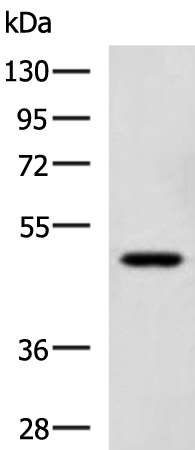

| WB | 咨询技术 | Human,Mouse,Rat |
| IF | 咨询技术 | Human,Mouse,Rat |
| IHC | 1/50-1/200 | Human,Mouse,Rat |
| ICC | 技术咨询 | Human,Mouse,Rat |
| FCM | 咨询技术 | Human,Mouse,Rat |
| Elisa | 1/5000-1/10000 | Human,Mouse,Rat |
| Aliases | PML1; PMRED |
| WB Predicted band size | 46 kDa |
| Host/Isotype | Rabbit IgG |
| Antibody Type | Primary antibody |
| Storage | Store at 4°C short term. Aliquot and store at -20°C long term. Avoid freeze/thaw cycles. |
| Species Reactivity | Human, Mouse, Rat |
| Immunogen | Fusion protein of human SNIP1 |
| Formulation | Purified antibody in PBS with 0.05% sodium azide and 50% glycerol. |
+ +
以下是3篇与SNIP1抗体相关的文献摘要信息,供参考:
---
1. **文献名称**: *SNIP1 regulates the stability of c-Myc oncoprotein by targeting its phosphorylation site*
**作者**: Leong et al.
**摘要**: 研究揭示SNIP1通过结合并调控c-Myc蛋白的磷酸化位点(Thr58/Ser62)影响其稳定性,促进肿瘤细胞增殖。文中使用SNIP1抗体进行免疫共沉淀(Co-IP)和Western blot分析,证实SNIP1与c-Myc的直接相互作用。
---
2. **文献名称**: *Smad nuclear interacting protein 1 (SNIP1) inhibits TGF-β signaling through targeting TβRI degradation*
**作者**: Kim et al.
**摘要**: 该研究证明SNIP1通过泛素-蛋白酶体途径促进TGF-β受体I(TβRI)的降解,从而抑制TGF-β信号通路。作者利用SNIP1抗体进行免疫荧光染色和蛋白质组学分析,阐明SNIP1在肿瘤微环境中的调控机制。
---
3. **文献名称**: *SNIP1 links the spliceosome to the DNA damage response*
**作者**: Zhang et al.
**摘要**: 研究发现SNIP1在DNA损伤修复中通过与剪接体组分(如SF3B1)相互作用,调控RNA剪接与损伤应答的协同作用。文中通过SNIP1抗体的ChIP-seq和RNA-seq实验,揭示了其在维持基因组稳定性中的功能。
---
4. **文献名称**: *SNIP1 promotes tumor angiogenesis through enhancing HIF-1α transcriptional activity*
**作者**: Wang et al.
**摘要**: 本文证明SNIP1通过增强HIF-1α与转录共激活因子p300的结合,促进肿瘤血管生成。研究使用SNIP1抗体进行组织芯片(TMA)免疫组化分析,发现SNIP1高表达与癌症患者预后不良显著相关。
---
以上文献涵盖了SNIP1在肿瘤信号转导、RNA剪接、DNA修复及血管生成中的功能研究,均涉及SNIP1抗体的实验应用。如需具体文献来源,建议通过PubMed或Web of Science检索标题或作者进一步获取全文。
**Background of SNIP1 Antibody**
SNIP1 (Smad Nuclear Interacting Protein 1) is a multifunctional protein involved in transcriptional regulation, notably interacting with key signaling pathways such as TGF-β/Smad, NF-κB, and c-Myc. It acts as a co-modulator of transcription factors, influencing processes like cell proliferation, differentiation, and apoptosis. SNIP1’s role in DNA damage response and stem cell maintenance has also been explored, highlighting its importance in both normal physiology and disease.
Antibodies targeting SNIP1 are critical tools for studying its expression, localization, and molecular interactions. These antibodies are commonly used in techniques like Western blotting, immunoprecipitation, and immunofluorescence to detect SNIP1 in cellular or tissue samples. Given SNIP1’s dual role as a tumor suppressor or promoter in context-dependent cancers (e.g., breast, colorectal), SNIP1 antibodies aid in elucidating its mechanistic contributions to oncogenesis and therapy resistance.
Validated SNIP1 antibodies typically demonstrate specificity through knockout cell controls or siRNA-mediated knockdown. Researchers also utilize them to explore SNIP1’s post-translational modifications and partnerships with proteins like p53 or BRCA1. Commercial SNIP1 antibodies are often raised against epitopes within its N-terminal or central regions. Reliable detection of SNIP1 enhances understanding of its regulatory networks, offering potential insights into therapeutic targeting in cancer and other diseases linked to transcriptional dysregulation.
×